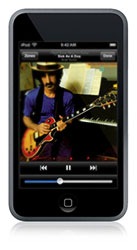![]()
![]()
![]()
 In itself the 1U Server seems fairly uninteresting but with the Kaleidescape Music Player in the mix it immediately turns into a hefty competitor in the media server market – even if it may appear somewhat uneconomical [diplomatically speaking].
In itself the 1U Server seems fairly uninteresting but with the Kaleidescape Music Player in the mix it immediately turns into a hefty competitor in the media server market – even if it may appear somewhat uneconomical [diplomatically speaking].
The server comes in two versions. The 1U has 1TB of storage which can be extended to 4TB through modular drive bays. The 3U also starts with 1TB but can be extended to a stunning 12TB. The really stunning part comes when you start clustering the servers in which case you reach a mindboggling 100TB of music and/or DVD storage. Now – let us assume that a CD contains 700MB of data [which, believe my, is a very high assumption] and you divide that into 100TB, you end up with 150,000 CDs. If the Kaleidescape servers didn’t already drain your bank accounts, the CD purchases might.
The server can cover 45 discrete zones and perform up to 4 simultaneous rips. The Kaleidescape Music Player is one of your options for those zones as well as a number of full HD video components. The Music Player itself can handle 4 discrete zones at a resolution of up to 24bit/192KHz and sports a CD/DVD drive in its sleek exterior.
 Frankly this gadget was hard to fit into this blog but somehow it needs to be here. It is actually two devices. The X-Fi Notebook is a PCCARD soundcard with built-in wireless transmission using the other part of the equation; the Creative Wireless Receiver.
Frankly this gadget was hard to fit into this blog but somehow it needs to be here. It is actually two devices. The X-Fi Notebook is a PCCARD soundcard with built-in wireless transmission using the other part of the equation; the Creative Wireless Receiver. With the receiver it should be possible to transmit music to 4 discrete zones, each equipped with one. In other words: With a decent notebook, an X-Fi Notebook and sufficient receivers, you could build a multi-zone streamer fairly easily. The soundcard itself supports resolutions up to 24bit/48KHz and works pretty much as any other soundcard.
With the receiver it should be possible to transmit music to 4 discrete zones, each equipped with one. In other words: With a decent notebook, an X-Fi Notebook and sufficient receivers, you could build a multi-zone streamer fairly easily. The soundcard itself supports resolutions up to 24bit/48KHz and works pretty much as any other soundcard. Someone at Crestron has nimbly avoided being called narrow minded for quite some time to come, hacking together this truly massive beast of features galore. Okay, it serves media; not just music but video as well. Video from DVD or Blu-ray as well as downloaded rentals. All this in full HD and 7.1 surround sound into 3 zones. Sound is served in a resolution of up to 24bit/96KHz and practically all formats known to man have been squeezed in.
Someone at Crestron has nimbly avoided being called narrow minded for quite some time to come, hacking together this truly massive beast of features galore. Okay, it serves media; not just music but video as well. Video from DVD or Blu-ray as well as downloaded rentals. All this in full HD and 7.1 surround sound into 3 zones. Sound is served in a resolution of up to 24bit/96KHz and practically all formats known to man have been squeezed in. The Cambridge Audio DacMagic has existed for a couple of years but has now had a sort of re-debut at
The Cambridge Audio DacMagic has existed for a couple of years but has now had a sort of re-debut at  The Nuvo Music port is not an audio device in its own right but an add-on for their large music systems such as NuVo Grand Concerto and NuVo Essentia E6G.
The Nuvo Music port is not an audio device in its own right but an add-on for their large music systems such as NuVo Grand Concerto and NuVo Essentia E6G. The Music Port is a hardware interface that connects a PC to the system and lets it not only control the NuVo systems but also act as a source. It even lets you collect music from other network places and aggregate them in one playlist. A PC with two 5.1 surround sound cards can then serve 6 streams and truly be a part of a cool setup.
The Music Port is a hardware interface that connects a PC to the system and lets it not only control the NuVo systems but also act as a source. It even lets you collect music from other network places and aggregate them in one playlist. A PC with two 5.1 surround sound cards can then serve 6 streams and truly be a part of a cool setup. Adding to their Squeezebox line-up, Logitech has recently released their Squeezebox Boom. It uses the same technology as the
Adding to their Squeezebox line-up, Logitech has recently released their Squeezebox Boom. It uses the same technology as the  It’s been a year since McIntosh introduced their larger than life [literally] music server
It’s been a year since McIntosh introduced their larger than life [literally] music server  Those who own both a
Those who own both a  The Avoca VIP Music Edition sports some pretty nice specs in a pretty case accompanied by a slightly less pretty PDA based controller. The media center rips CDs to
The Avoca VIP Music Edition sports some pretty nice specs in a pretty case accompanied by a slightly less pretty PDA based controller. The media center rips CDs to  Behind the curious title, lies the modification of the
Behind the curious title, lies the modification of the